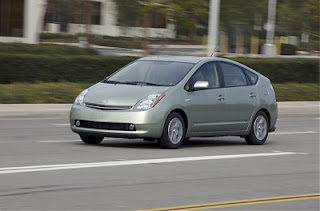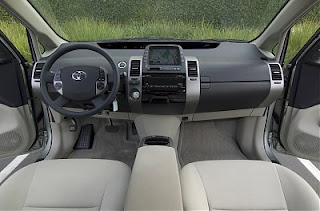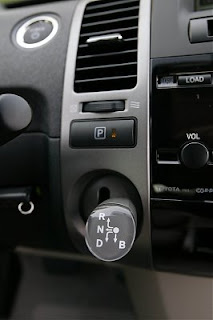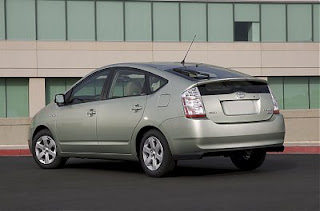2008 Toyota Prius Review
By Chris Haak
02.18.2008
The Toyota Prius has been on a real sales tear for the past year. US sales of the hybrid five-door leapt from 106,971 in 2006 to 181,221 in 2007 (a 69.4% increase). Prius sales were slightly down from 2005 to 2006, but were up another 37.1% in January 2008 compared to January 2007.
So, what makes this car successful? Is it a great car, or just a car boosted by its name recognition and its own green hype? I borrowed one for a week from Toyota to find out for myself.
Exterior The Prius won’t win any beauty contests. It’s nearly slab-sided with an extreme wedge shape. Let’s be kind and say that form follows function; its shape minimizes hood space (not needed because its small 1.5 liter four cylinder occupies little space) and maximizes passenger area, while putting aerodynamics ahead of most. For example, the roof’s highest point is above the front passengers’ heads, but it then quickly angles downward to the back bumper, to the benefit of fuel efficiency, but at the cost of rear passenger headroom. If you’re over six feet tall, your head will probably hit the ceiling in the back. At 6’4″, I didn’t stand a chance. If you drive a Prius, expect people to notice you, for better or worse, in spite of the vehicle being toward the top of the sales charts.
The Prius won’t win any beauty contests. It’s nearly slab-sided with an extreme wedge shape. Let’s be kind and say that form follows function; its shape minimizes hood space (not needed because its small 1.5 liter four cylinder occupies little space) and maximizes passenger area, while putting aerodynamics ahead of most. For example, the roof’s highest point is above the front passengers’ heads, but it then quickly angles downward to the back bumper, to the benefit of fuel efficiency, but at the cost of rear passenger headroom. If you’re over six feet tall, your head will probably hit the ceiling in the back. At 6’4″, I didn’t stand a chance. If you drive a Prius, expect people to notice you, for better or worse, in spite of the vehicle being toward the top of the sales charts.
Interior In spite of technically being classified as a midsize vehicle by the EPA, the Prius feels much smaller than an Accord or Camry, although in terms of volume, the Camry and Prius are relatively close (EPA passenger volume of 101.4 cubic feet for the Camry versus 96.2 cubic feet for the Prius), but the narrower width of the Prius (67.9 inches versus 71.7 inches for the Camry) make the vehicle feel more confining. Also, as noted earlier, the rear roofline drop in the Prius costs about an inch and a half of headroom compared to the Camry. Still, for a small car that is outweighed by the Camry by over 500 pounds in some models, the Prius is a marvel of packaging. From the driver’s seat, with the seat all the way back, I had no complaints about space, though it’s definitely narrower than I am used to in my 2004 Honda Accord.
In spite of technically being classified as a midsize vehicle by the EPA, the Prius feels much smaller than an Accord or Camry, although in terms of volume, the Camry and Prius are relatively close (EPA passenger volume of 101.4 cubic feet for the Camry versus 96.2 cubic feet for the Prius), but the narrower width of the Prius (67.9 inches versus 71.7 inches for the Camry) make the vehicle feel more confining. Also, as noted earlier, the rear roofline drop in the Prius costs about an inch and a half of headroom compared to the Camry. Still, for a small car that is outweighed by the Camry by over 500 pounds in some models, the Prius is a marvel of packaging. From the driver’s seat, with the seat all the way back, I had no complaints about space, though it’s definitely narrower than I am used to in my 2004 Honda Accord.
The design of the interior does its best to keep the space-age theme of the exterior intact. To that end, there is no gauge cluster in front of the driver. Instead, a horizontal row of digital gauges (mainly a speedometer and fuel gauge) are further forward, at the base of the windshield. This relocation allows for a small circumference steering wheel, which I appreciated, because it doesn’t have to be large enough to see gauges through the top half of it. There is a standard touch screen LCD display at the top of the center stack; models with navigation obviously have the navigation system in this location. Unfortunately, my model was more basic and lacked navigation, but the screen was still important, as it was the main control and display for audio, climate, and fuel consumption functions. In spite of being a technophile and having no issues with high-tech things, it was a bit annoying to have to move to the “climate” function to check the temperature setting or to the audio function to check the current radio station. However, Toyota does help a bit with this issue by having more duplicate controls than normal on the steering wheel. Functions on the wheel include temperature up/down, front and rear defog on/off, audio mode, audio volume and audio preset up/down. There were several storage spaces scattered around the interior, including a center console, a cubby beneath the radio, and dual glove boxes, so that was not an issue. The seats were comfortable yet firm (just as I like them). Visibility to the rear was compromised by the split window treatment (the top half of the rear hatch is nearly horizontal, while the bottom half of the rear hatch is nearly vertical and contains a window. My tester had the optional backup camera, which made backing up less of a chore, although its beeping while reverse was engaged made visions of driving a large truck swirl through my mind. (The beeping occurs only inside the car, of course). Cargo capacity is reasonable, although being a hatchback, you have to load the trunk vertically to take advantage of its full cargo volume. Second row seats fold flat for additional cargo flexibility.
Driving Experience
I already had sat in a few Priuses, and was very familiar with the way they looked, but I had never driven one before, and was looking forward to seeing what the experience was like. The smart key-equipped model I drove allowed me to keep the key fob in my pocket at all times, unlocking the front doors when I touched the handles and locking them if the transmitter was outside the car by touching a small button on the door handle. Just in case of an electrical problem, the transmitter conceals a physical key inside it that can be used to enter the car in emergencies. I think I figured out one area that Toyota saved some of the 500 pound weight difference from the Camry to the Prius: the doors opened with a light, hollow sound. They seemed to close with an authoritative “clunk,” but they felt a little chintzy when pulling the handle and hearing an echo as they opened.
Once in the driver’s seat, transmitter still in my pocket, I was greeted by a large circular power button on the dashboard. More basic models not equipped with the smart key system need the driver to “dock” the transmitter into the dashboard before pressing the start button, but this was not necessary in my test vehicle. To turn the car on (since by doing so, you aren’t necessarily “starting it” – more on that later), you just put your foot on the brake pedal and press the power button. The car hums and whirs for a few seconds, and a green “ready” light appears on the dash. Pressing the power button without one’s foot on the brake will turn the car onto accessory only mode, which is fine for listening to the radio, but doesn’t get you very far on the road.
 The gearshift is a stubby little contraption below the power button on the dashboard that is completely electronic, unlike any gearshift I’d used before. To engage reverse or drive, simply keep your foot on the brake and move the joystick-like gearshift to R or D. Once you arrive at your destination, park is engaged by pressing a P button above the gearshift lever. The parking brake, surprisingly, is a conventional cable-operated foot pedal.
The gearshift is a stubby little contraption below the power button on the dashboard that is completely electronic, unlike any gearshift I’d used before. To engage reverse or drive, simply keep your foot on the brake and move the joystick-like gearshift to R or D. Once you arrive at your destination, park is engaged by pressing a P button above the gearshift lever. The parking brake, surprisingly, is a conventional cable-operated foot pedal.
Driving the Prius was – interesting. Transitions where the gasoline engine engages are noticeable, but not by any means harsh. On cold mornings as we’ve had in Pennsylvania for the past week, the gasoline engine has to run to warm up for interior heat, even if the hybrid system would otherwise not need it. For this reason, Toyota recommends grouping trips together to get maximum fuel economy, as a warmed-up Prius will only need to run the gasoline engine for extra power or to recharge its batteries. Proving this point, on my 20-mile commute to work, I got the best fuel economy the first morning because the car was covered by ice and I warmed it up in the driveway for 15 minutes before leaving, and I reset the fuel consumption calculator as I started driving.
When the engine is warmed up and the battery is sufficiently charged, the Prius can (in my experience) drive up to about 20 miles per hour solely on electric power, if the driver has a gentle right foot. I tested this by turning off the heater and stereo (to clearly hear the silence of the engine not running) and driving from one end of our local shopping center to another solely on electric power. It’s an interesting experiment (if also slightly dangerous; one woman who probably didn’t hear the car nearly walked in front of me), but almost more of a video game-type novelty to me more than anything. Electric-only operation is great to have toward the end of my commute every morning, where two expressways merge together and traffic backs up. In fact, the car seemed to get its best economy in this situation, since the engine doesn’t run when the car is stopped, and crawling slowly toward the crowded merge point can be done with the electric motor only.
Returning to my earlier comment about the experience being video game-like, the LCD display encourages this perception by showing the battery’s charge status, whether the engine is running, whether the electric motor is engaged, whether the battery is being charged or discharged, and the instant fuel economy to one decimal place (it shows 99.9 when on electric-only operation, though technically it’s an infinite mpg, because it’s using no gasoline). The info computer also has a consumption feature that is the most detailed fuel economy record I’ve ever seen in a vehicle. Not only does it show the average economy since the last reset, but also the number of miles since it was reset, instant mileage on a constantly-moving bar graph, but also a running series of bar graphs showing the average economy at five minute intervals for the previous 30 minutes. These bar graphs also show the amount of electricity regenerated and put back into the battery during each five minute period.
So, what does it feel like to drive a Prius, other than the unique experience of the start/stop process and EV-only operation? Driven conservatively, it feels almost like a normal, albeit a very underpowered car, with some unusual sounds added and occasionally normal sounds subtracted. However, merging into a fast-moving expressway is an adventure, as the tiny engine howls and wheezes as it struggles to get the car up to speed. If you’re in the right lane and see a small opening in the fast-moving left lane, there’s almost no chance of getting it without eliciting a rude gesture from the car that will be behind you. A V6 midsize sedan could handle those scenarios with no issues, and even newer four cylinders with horsepower ratings in the high 100s (around 165-175 for most) could probably handle that scenario. Steering is electric rather than hydraulic, which is a necessity in a car in which the engine may or may not be running, but definitely lacks feel. However, I’d rate it higher than the electric power steering in the Chevrolet Cobalt 1LT that I drove a few months ago. I did not push the limits of the car’s handling; although it did not feel unsafe by any means, a narrow track coupled with small wheels (only 15 inches) and Toyota’s preferred soft suspension tuning did not inspire confidence.
The other issue with driving a Prius is not how the car drives, but how other drivers react to it. Some people really love the Prius, what it stands for, and how it reflects upon its owners’ choices and priorities; others feel that Prius drivers are smug, holier-than-thou do-gooders who think they’re smarter than everyone else. Personally, I probably fall somewhere in the middle, although I definitely noticed both extremes in my time with the car. For example, one evening on my commute home from work, a guy driving a 2001 Mustang GT clearly couldn’t stomach the thought of having a Prius in front of him on the highway. I didn’t do anything to him, but he tried passing me on the right several times (traffic was relatively heavy and many cars were traveling in the left lane). He probably assumed that I’d be a traffic impediment on his way home.
The strange nature of the Prius’ power on/off routine can also lend itself to problems. For example, when I arrived at work one morning, the Prius was in EV mode while I glided into my parking spot. I put the car in park and thought that I turned it off (the engine was not running), but when I got back to the car hours later, I was horrified to see that it was idling for the entire time. At least the car was warm for me on a cold day. The downside was that hours of idling cost the average fuel economy dearly.
Bottom Line The Prius is not a great car, but it does serve its primary purposes – saving fuel and advertising Toyota’s environmental leadership – better than almost any other vehicle on the market. The lack of engine power, numb steering, indifferent handling, and the “look, I’m a tree hugger!” exterior appearance would prevent me from owning a Prius. I was, however, very impressed by the fuel economy (typically between 44 and 47 miles per gallon on my commute that usually makes my V6 Accord get between 22 and 23 miles per gallon) as well as the impressive technology that underpins the Hybrid Synergy Drive system. I’d be curious to try a Toyota Camry Hybrid for a week, which probably gives a more “normal” experience with only a small penalty in mileage and none of the “baggage” that some associate with the Prius.
The Prius is not a great car, but it does serve its primary purposes – saving fuel and advertising Toyota’s environmental leadership – better than almost any other vehicle on the market. The lack of engine power, numb steering, indifferent handling, and the “look, I’m a tree hugger!” exterior appearance would prevent me from owning a Prius. I was, however, very impressed by the fuel economy (typically between 44 and 47 miles per gallon on my commute that usually makes my V6 Accord get between 22 and 23 miles per gallon) as well as the impressive technology that underpins the Hybrid Synergy Drive system. I’d be curious to try a Toyota Camry Hybrid for a week, which probably gives a more “normal” experience with only a small penalty in mileage and none of the “baggage” that some associate with the Prius.
COPYRIGHT Full Metal Autos – All Rights Reserved


